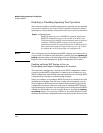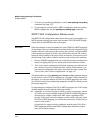
4-43
Multiple Instance Spanning-Tree Operation
Configuring MSTP
■ Flexibility: By preconfiguring identical VLAN ID-to-MSTI mappings on all
switches in an MST region, you can combine switches that support
different maximum numbers of VLANs.
■ Network stability: You can reduce the interruptions in network connec-
tivity caused by the regeneration of spanning trees in the entire network
each time a configuration change in VLAN-to-MSTI mapping is detected
on a switch. The negative impact on network performance is reduced if
all newly created VLANs are pre-mapped to the correct MST instances.
Later, VLAN creation and deletion are ignored by MSTP and no interrup-
tion in spanning-tree traffic occurs.
■ Usability: Dynamically learned GVRP VLANs can be mapped to MSTIs and
support MSTP load balancing.
PreConfiguring VLANs in an MST Instance
When you configure an MSTP regional topology, you create multiple spanning-
tree instances. Each MST instance provides a fully connected active topology
for a particular set of VLANs.
Each switch in an MSTP region is configured with the following set of common
parameters:
■ Region name (spanning-tree config-name)
■ Region revision number (spanning-tree config-revision)
■ Identical VLAN ID-to-MSTI mapping (spanning-tree instance vlan)
Each MST instance supports a different set of VLANs. A VLAN that is mapped
to an MST instance cannot be a member of another MST instance.
The MSTP VLAN configuration enhancement allows you to ensure that the
same VLAN ID-to-MSTI assignments exist on each MSTP switch in a region.
Before a static VLAN is configured or a dynamic VLAN is learned on the switch,
you can used the spanning-tree instance vlan command to map VLANs to each
MST instance in the region. Later, when the VLAN is created, the switch
automatically assigns it to the MST instance to which you had previously
mapped it.


















